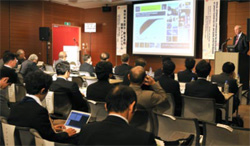Home > Highlighting JAPAN > Highlighting Japan NOVEMBER 2011 > Symposium on Tourism
Highlighting JAPAN
TOPICS
Symposium on Tourism

Secretary-General Taleb Rifai of the UNWTO delivers the opening address at the Special International Symposium on the Revitalization of Japan's Tourism Sector and Quake Affected Regions, October 5.
Credit: KAZUE HASHIZUME
In the opening address, Secretary-General Taleb Rifai of the UNWTO, which is in charge of tourism at the United Nations, dedicated a minute of silence to the victims of the disaster, and then stated, "The facts about the Great East Japan Earthquake and actions of the Japanese people for overcoming the difficulties that resulted have been conveyed to the world with a feeling of awe and respect, and the world has come to know wonderful aspects of Japan." He also mentioned the UNWTO's statement that Japan is safe for tourists, which was issued about a month after the disaster, and said "There is nothing to prevent travel to Japan or the Tohoku region and the message will continue to be sent out to the world. Japan has friends all over the world, and the world is supporting Japan."
In the keynote presentation titled "Impacts of Large-scale Natural Disasters on Global Tourism and the Significance of Post-disaster Recovery," Dirk Glaesser, coordinator of Risk and Crisis Management of the UNWTO, emphasized the importance of communicating favorable information about the region to remove preconceived notions among travelers worried about risks. Glaesser mentioned an example of a hotel that made its lobby and other spaces available for affected people other than hotel guests on the night of the disaster, and stated that such instances not only give hope to people but also bring about significant synergistic effects for restoring tourism.
In the presentation on affected areas that followed, representatives in charge of tourism in Iwate, Miyagi and Fukushima Prefectures, in which coastal areas suffered serious damage, and those from Aomori, Akita and Yamagata Prefectures, which did not suffer direct damage but were hurt by harmful rumors, made presentations on initiatives by affected localities for restoring tourism. Reports were given on various subjects such as damage situations and effects on tourism in each prefecture, environmental impacts of the Fukushima Daiichi Nuclear Power Plant accident and initiatives for restoring and promoting tourism being actively pursued, and supportive measures by China, Hong Kong, South Korea and Taiwan, from which many tourists came prior to the disaster, and organizations for collaboration with them.

About 170 people participated in the Special International Symposium at Tohoku University to discuss revitalization of the tourism sector.
Credit: KAZUE HASHIZUME
In the panel discussion held in the latter part of the program, opinions were actively exchanged with participation by Professor Emeritus Seiji Komori of the Kobe University of Commerce and the head of the Kobe Recovery Workshop, who has taken part in recovery assistance in affected areas. President Kazuhiko Saito of the Iwaki Tourism and City Planning Bureau, who also serves as president of the Joban Kosan which runs Spa Resort Hawaiians in Iwaki, Fukushima Prefecture, reported on the outcomes of a nationwide tour by the Hula Girls which symbolized restoration after the disaster (see pp. 16–17).
The panel discussion closed with the following words from Director Fumiha Ise of the International Economy and Tourism Department of Sendai City.
"The disaster was indeed unfortunate. However, bonds of friendship are found in the care and attention shown for Tohoku by people around the world. We hope to build new tourism attractions with the resilience of the people of the Tohoku region, which is set for restoration."
At the symposium, a special message was adopted: "It is important to quell damaging misperception and misinformation as quickly as possible by continuing to share accurate information with the world on the revitalization of tourism in disaster-affected areas and the Tohoku region as a whole. … It is crucial to restore and increase the number of visitors to Tohoku and Japan, and to work toward further growth of international tourism in the Asia-Pacific region."
© 2009 Cabinet Office, Government of Japan






